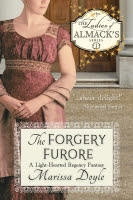As I have in previous posts, I’ll be examining actual fabric samples glued into several earlier editions of Ackermann’s Repository, samples supplied by the manufacturers and published by Ackermann in order to boost the British cloth-making industry at a time when exporting British goods to Europe was almost impossible because of the Napoleonic war. I'll give you a close-up scan of each sample, the published description if available, and my own observations of the color, weight, condition, and similarity to present-day materials, to give you as close a picture as possible of what these fabrics are like. So here we go!
Today’s three samples are from
the January 1811 issue of Ackermann’s Repository. The overall condition of my
copy is excellent: the page has been trimmed but is otherwise free of foxing
and toning, and the fabric samples themselves appear to be in fine shape.
Here we go!
Nos. 1 and 2. A printed cotton, lace pattern, particularly adapted for
half-mourning dresses. From the elegance of the pattern, we presume that it is
likely to become a favourite article with our fashionable females for morning
or domestic wear. It is furnished by Churchill and Blomefield, 36, King-street,
Cheap-side.
My comments: All of the fabrics in this month’s offering are
suitable for mourning use, likely in acknowledgement of court mourning after
the death of George III’s youngest daughter, Princess Amelia, in November 1810.
This print looks remarkably like a net lace, doesn’t it? It’s similar in weight
to today’s quilting cotton fabrics, though the weave itself is not as smoothly
woven as a quilting cotton, having a lot of slubs not visible on the printed face of the fabric but clearly in view on the reverse..
No. 3. A silver grey embossed satin, particularly adapted for slight
mourning. With robes of this article every order of black trimming, and bugle
or jet ornaments, are consistent. The robe should be constructed plain, with a
short Grecian sleeve and demi-traine, the robe sitting close to the bust.
Furnished by Messrs. Cooper’s, Pall-Mall.
My comments: What lovely fabric! It’s hard to judge whether the
color has changed—it is over two hundred years old, after all—but this appears
more blue than silver grey. I’m guessing the fiber is silk, based on the sheen
and the smooth hand; it would drape beautifully
No. 4. A grey and black imperial cambric, calculated for the
intermediate or morning costume. The Flemish jacket, and simple round gown,
with antique stomacher and sleeve, each trimmed or ornamented with black
velvet, and trimmed round the throat and cuffs with full plaitings of black
net, or black Vandyke lace, are the most tasteful habits we have seen of this
material. It may be procured at Messrs. Smith’s, 43, Tavistock-street,
Covent-Garden.
My comments: Again, I would call this blue rather than grey, but
there may also have been some color change over the centuries. The fabric is woven
with a slight rib set on the diagonal which, combined with the print, gives it pleasant visual
interest. The weave is very fine and even with a smooth, drape-y hand, opaque
enough not to require an underdress.









No comments:
Post a Comment